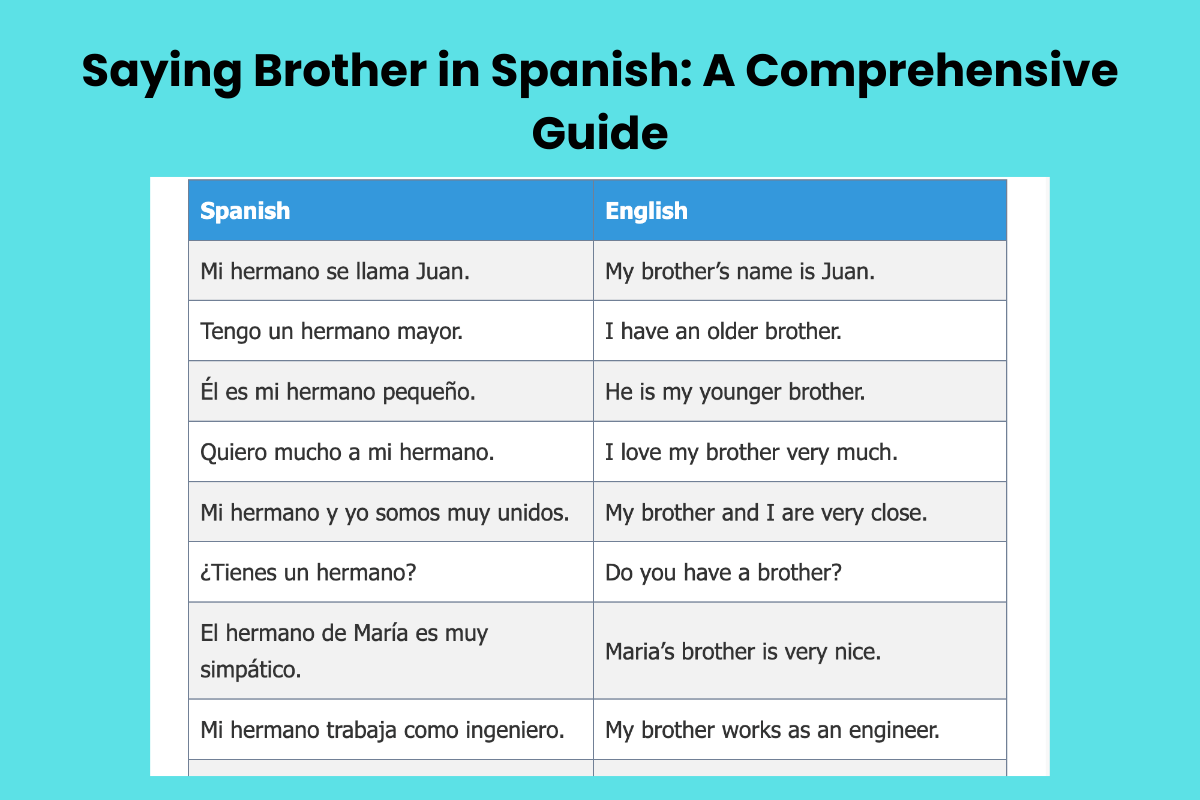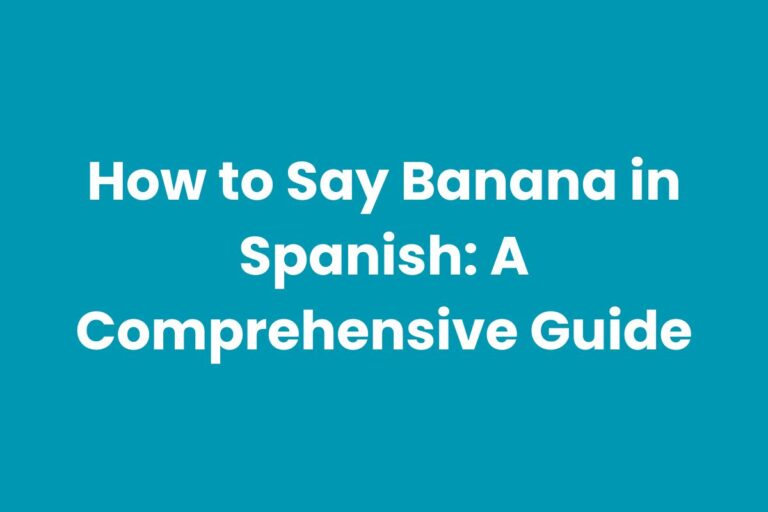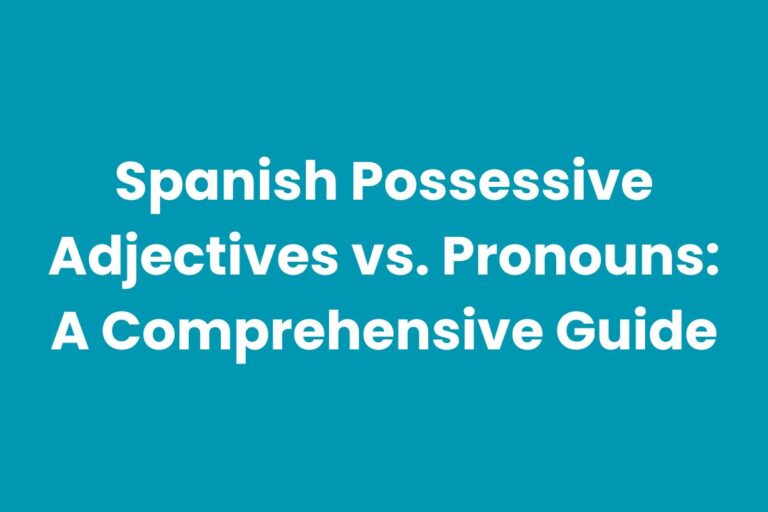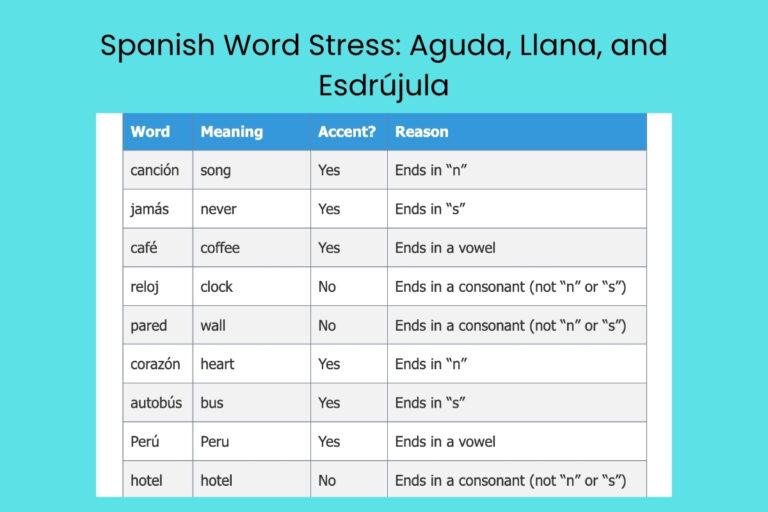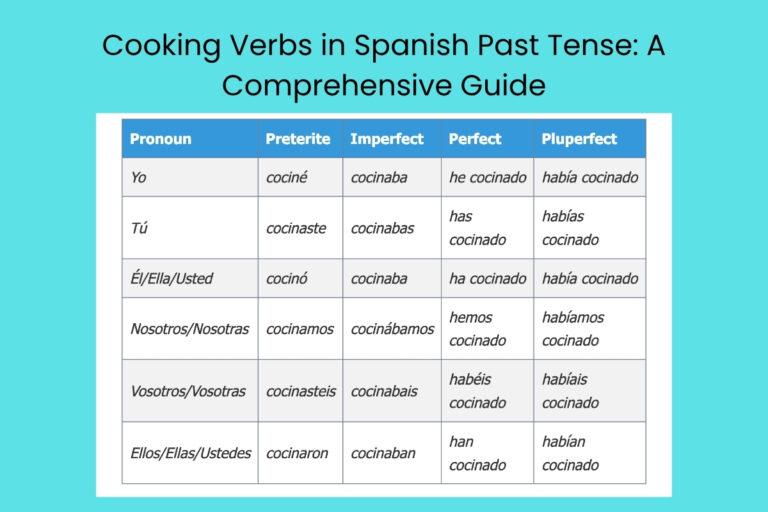Saying Brother in Spanish: A Comprehensive Guide
Understanding how to say “brother” in Spanish, and its various forms and nuances, is crucial for effective communication in Spanish-speaking environments. This seemingly simple word has several variations depending on context, number, and relationships.
Mastering these forms allows you to accurately express familial connections and relationships in both formal and informal settings. This guide provides a detailed exploration of “brother” in Spanish, covering its definitions, structural elements, usage rules, common mistakes, and practical exercises.
This article is ideal for students, travelers, and anyone looking to improve their Spanish language skills and cultural understanding.
Table of Contents
- Introduction
- Definition of “Brother” in Spanish
- Structural Breakdown
- Types and Categories
- Examples
- Usage Rules
- Common Mistakes
- Practice Exercises
- Advanced Topics
- FAQ
- Conclusion
Definition of “Brother” in Spanish
The most common translation for “brother” in Spanish is hermano. This term refers to a male sibling sharing at least one parent with another person. The word hermano stems from the Latin word germanus, meaning “sibling.” Understanding its definition is the first step towards using it correctly in Spanish.
In Spanish, nouns have grammatical gender, and hermano is a masculine noun. This means it will typically be used with masculine articles and adjectives. For example, you would say el hermano (the brother) and not la hermano (which is grammatically incorrect). Grammatical gender is an essential aspect of Spanish and affects how words are used in sentences.
The word hermano can also be used in a broader sense to refer to brotherhood or camaraderie. This usage extends beyond familial relationships to include close friends or members of a community who share a strong bond. In this context, it carries a sense of unity and mutual support. This broader usage is similar to the English word “brother” when used in phrases like “brothers in arms.”
Structural Breakdown
The structure of the word hermano is relatively straightforward. It consists of the root herman-, which carries the core meaning of sibling, and the masculine suffix -o. This suffix indicates that the noun is masculine and singular. Changing the suffix to -a creates the feminine form, hermana (sister). This simple change illustrates how Spanish uses suffixes to indicate gender.
To form the plural of hermano, you add an -s to the end of the word, resulting in hermanos. This is the standard way to pluralize most nouns in Spanish that end in a vowel. The plural form hermanos can refer to multiple brothers, or to a group of siblings that includes both brothers and sisters. This inclusive usage is common in Spanish.
When using hermano in a sentence, it typically follows the subject-verb-object order common in Spanish. However, the placement of articles and adjectives can vary depending on the specific construction and emphasis. For instance, you might say “Mi hermano es alto” (My brother is tall), where the adjective alto (tall) follows the noun hermano. Understanding these structural elements is key to constructing grammatically correct sentences.
Types and Categories
Hermano
Hermano is the most common and direct translation of “brother.” It refers to a male sibling who shares at least one parent with you. This is the basic and most frequently used term in Spanish-speaking countries.
Hermanos
Hermanos is the plural form of hermano, meaning “brothers.” It can also refer to a group of siblings that includes both brothers and sisters. The context usually clarifies whether it refers exclusively to brothers or to a mixed group.
Medio Hermano
Medio hermano translates to “half-brother.” It refers to a male sibling who shares only one parent with you. This term is important for specifying the exact nature of the sibling relationship.
Hermanastro
Hermanastro means “stepbrother.” It refers to the son of your stepparent, or the stepson of your parent. This term is used to describe relationships formed through marriage rather than blood.
Examples
Examples with Hermano
The following table provides examples of how to use “hermano” in various sentences. These examples illustrate different contexts and sentence structures.
| Spanish | English |
|---|---|
| Mi hermano se llama Juan. | My brother’s name is Juan. |
| Tengo un hermano mayor. | I have an older brother. |
| Él es mi hermano pequeño. | He is my younger brother. |
| Quiero mucho a mi hermano. | I love my brother very much. |
| Mi hermano y yo somos muy unidos. | My brother and I are very close. |
| ¿Tienes un hermano? | Do you have a brother? |
| El hermano de María es muy simpático. | Maria’s brother is very nice. |
| Mi hermano trabaja como ingeniero. | My brother works as an engineer. |
| Estoy orgulloso de mi hermano. | I am proud of my brother. |
| Mi hermano vive en otra ciudad. | My brother lives in another city. |
| Hablo con mi hermano todos los días. | I talk to my brother every day. |
| Mi hermano es mi mejor amigo. | My brother is my best friend. |
| El hermano de Pedro es médico. | Pedro’s brother is a doctor. |
| Mi hermano está casado. | My brother is married. |
| El hermano de mi madre es mi tío. | My mother’s brother is my uncle. |
| Mi hermano y yo jugábamos juntos de niños. | My brother and I used to play together as kids. |
| Admiro a mi hermano. | I admire my brother. |
| Mi hermano siempre me apoya. | My brother always supports me. |
| El hermano de mi padre es mi tío. | My father’s brother is my uncle. |
| Mi hermano y yo tenemos una buena relación. | My brother and I have a good relationship. |
| Mi hermano me ayuda con mis deberes. | My brother helps me with my homework. |
| Mi hermano es muy divertido. | My brother is very funny. |
| El hermano de mi vecina es policía. | My neighbor’s brother is a police officer. |
| Mi hermano cocina muy bien. | My brother cooks very well. |
| Mi hermano es un gran músico. | My brother is a great musician. |
Examples with Hermanos
The following examples demonstrate the use of “hermanos” in different contexts, highlighting its plural form and inclusive meaning.
| Spanish | English |
|---|---|
| Tengo tres hermanos. | I have three siblings/brothers. |
| Mis hermanos son muy simpáticos. | My siblings/brothers are very nice. |
| Los hermanos de Ana son estudiantes. | Ana’s siblings/brothers are students. |
| Somos hermanos. | We are siblings/brothers. |
| ¿Cuántos hermanos tienes? | How many siblings/brothers do you have? |
| Mis hermanos y yo vivimos juntos. | My siblings/brothers and I live together. |
| Adoro a mis hermanos. | I adore my siblings/brothers. |
| Mis hermanos me visitan a menudo. | My siblings/brothers visit me often. |
| Los hermanos Smith son muy conocidos. | The Smith siblings/brothers are well-known. |
| Mis hermanos son mi familia. | My siblings/brothers are my family. |
| Siempre estoy ahí para mis hermanos. | I am always there for my siblings/brothers. |
| Mis hermanos y yo nos llevamos muy bien. | My siblings/brothers and I get along very well. |
| Los hermanos Rodríguez son muy unidos. | The Rodríguez siblings/brothers are very close. |
| Mis hermanos me apoyan en todo. | My siblings/brothers support me in everything. |
| Los hermanos de mi madre son mis tíos. | My mother’s siblings/brothers are my uncles. |
| Mis hermanos y yo crecimos juntos. | My siblings/brothers and I grew up together. |
| Los hermanos de mi padre son mis tíos. | My father’s siblings/brothers are my uncles. |
| Mis hermanos siempre me hacen reír. | My siblings/brothers always make me laugh. |
| Los hermanos García son muy talentosos. | The García siblings/brothers are very talented. |
| Mis hermanos y yo somos muy diferentes. | My siblings/brothers and I are very different. |
| Los hermanos Pérez tienen un restaurante. | The Pérez siblings/brothers own a restaurant. |
| Mis hermanos y yo celebramos la Navidad juntos. | My siblings/brothers and I celebrate Christmas together. |
| Los hermanos López trabajan en la misma empresa. | The López siblings/brothers work in the same company. |
| Mis hermanos y yo nos ayudamos mutuamente. | My siblings/brothers and I help each other. |
| Los hermanos Fernández son muy deportistas. | The Fernández siblings/brothers are very athletic. |
Examples with Medio Hermano/a
This table illustrates the usage of “medio hermano” and “media hermana” to specify half-siblings.
| Spanish | English |
|---|---|
| Tengo un medio hermano por parte de mi padre. | I have a half-brother on my father’s side. |
| Ella es mi media hermana. | She is my half-sister. |
| Mi medio hermano vive en otro país. | My half-brother lives in another country. |
| Nunca he conocido a mi medio hermano. | I have never met my half-brother. |
| Mi media hermana es muy amable. | My half-sister is very kind. |
| Él tiene una media hermana. | He has a half-sister. |
| Mi medio hermano es mayor que yo. | My half-brother is older than me. |
| Mi media hermana es menor que yo. | My half-sister is younger than me. |
| Considero a mi medio hermano como un hermano verdadero. | I consider my half-brother as a true brother. |
| Mi media hermana y yo somos muy diferentes. | My half-sister and I are very different. |
| No veo a mi medio hermano muy a menudo. | I don’t see my half-brother very often. |
| Mi media hermana estudia en la universidad. | My half-sister studies at the university. |
| Mi medio hermano trabaja en una oficina. | My half-brother works in an office. |
| Mi media hermana está casada. | My half-sister is married. |
| Mi medio hermano tiene hijos. | My half-brother has children. |
| Mi media hermana vive cerca de mi casa. | My half-sister lives near my house. |
| Mi medio hermano es muy inteligente. | My half-brother is very intelligent. |
| Mi media hermana es muy creativa. | My half-sister is very creative. |
| Mi medio hermano es un buen cocinero. | My half-brother is a good cook. |
| Mi media hermana es una buena deportista. | My half-sister is a good athlete. |
| Mi medio hermano siempre me ayuda. | My half-brother always helps me. |
| Mi media hermana siempre me apoya. | My half-sister always supports me. |
| Mi medio hermano es muy divertido. | My half-brother is very funny. |
| Mi media hermana es muy amable. | My half-sister is very kind. |
| Mi medio hermano es muy trabajador. | My half-brother is very hardworking. |
Examples with Hermanastro/a
This table provides examples of using “hermanastro” and “hermanastra” to refer to stepbrothers and stepsisters.
| Spanish | English |
|---|---|
| Mi hermanastro es el hijo de mi madrastra. | My stepbrother is my stepmother’s son. |
| Ella es mi hermanastra. | She is my stepsister. |
| Mi hermanastro y yo nos llevamos bien. | My stepbrother and I get along well. |
| No tengo mucho en común con mi hermanastro. | I don’t have much in common with my stepbrother. |
| Mi hermanastra es muy simpática. | My stepsister is very nice. |
| Él tiene un hermanastro. | He has a stepbrother. |
| Mi hermanastro es mayor que yo. | My stepbrother is older than me. |
| Mi hermanastra es menor que yo. | My stepsister is younger than me. |
| Considero a mi hermanastro como un amigo. | I consider my stepbrother as a friend. |
| Mi hermanastra y yo somos muy diferentes. | My stepsister and I are very different. |
| No veo a mi hermanastro muy a menudo. | I don’t see my stepbrother very often. |
| Mi hermanastra estudia en la universidad. | My stepsister studies at the university. |
| Mi hermanastro trabaja en una oficina. | My stepbrother works in an office. |
| Mi hermanastra está casada. | My stepsister is married. |
| Mi hermanastro tiene hijos. | My stepbrother has children. |
| Mi hermanastra vive cerca de mi casa. | My stepsister lives near my house. |
| Mi hermanastro es muy inteligente. | My stepbrother is very intelligent. |
| Mi hermanastra es muy creativa. | My stepsister is very creative. |
| Mi hermanastro es un buen cocinero. | My stepbrother is a good cook. |
| Mi hermanastra es una buena deportista. | My stepsister is a good athlete. |
| Mi hermanastro siempre me ayuda. | My stepbrother always helps me. |
| Mi hermanastra siempre me apoya. | My stepsister always supports me. |
| Mi hermanastro es muy divertido. | My stepbrother is very funny. |
| Mi hermanastra es muy amable. | My stepsister is very kind. |
| Mi hermanastro es muy trabajador. | My stepbrother is very hardworking. |
Usage Rules
When using hermano, it’s important to remember its grammatical gender. Always use masculine articles and adjectives with it, such as el hermano or mi hermano. Similarly, use feminine articles and adjectives with hermana, such as la hermana or mi hermana.
For plural forms, use hermanos to refer to multiple brothers or a group of siblings including both genders. For a group of only sisters, use hermanas. The context usually makes it clear which meaning is intended.
When specifying the type of sibling relationship, use medio hermano/a for half-siblings and hermanastro/a for step-siblings. These terms are crucial for clarity, especially when discussing family relationships in detail.
In formal contexts, it’s generally more appropriate to use the full terms medio hermano/a and hermanastro/a. In informal settings, you might hear shortened versions or more casual expressions, but it’s best to stick to the formal terms when in doubt.
Remember that Spanish word order can sometimes be flexible, but the basic subject-verb-object structure usually applies. Ensure that articles and adjectives agree in gender and number with the noun hermano.
Common Mistakes
One common mistake is using the wrong gender article with hermano or hermana. For example, saying la hermano instead of el hermano is incorrect. Always remember that hermano is masculine and hermana is feminine.
Another mistake is confusing hermanos (siblings or brothers) with hermanas (sisters). Be mindful of the context to ensure you’re using the correct term. For instance, if you have two brothers and one sister, you would say “Tengo tres hermanos” (I have three siblings), not “Tengo dos hermanos y una hermana” (I have two brothers and one sister) unless you want to emphasize the specific number of each.
Using hermano to refer to a stepbrother or half-brother without specifying the relationship is also a common error. Always use medio hermano/a or hermanastro/a when necessary to avoid confusion.
A common mistake is to forget the gender agreement between nouns and adjectives. For example, saying “Mi hermano es bonita” is incorrect. The correct form is “Mi hermano es bonito” because hermano is masculine.
Another frequent error is using the incorrect plural form. For example, saying “Tengo dos hermano” is incorrect.
The correct form is “Tengo dos hermanos.”
Here are some examples of common mistakes and their corrections:
| Incorrect | Correct | Explanation |
|---|---|---|
| La hermano es alto. | El hermano es alto. | “Hermano” is masculine, so it needs the masculine article “el.” |
| Tengo dos hermano. | Tengo dos hermanos. | The plural form of “hermano” is “hermanos.” |
| Mi hermano es bonita. | Mi hermano es bonito. | Adjectives must agree in gender with the noun. |
| Él es mi hermanastro verdadero. | Él es mi hermanastro. | “Hermanastro” already implies a stepbrother relationship, so “verdadero” is redundant. |
| Mis hermanos son muy amable. | Mis hermanos son muy amables. | Adjectives must agree in number with the noun. |
Practice Exercises
Complete the following sentences with the correct form of “brother” in Spanish.
| Question | Answer |
|---|---|
| 1. Mi ______ se llama Carlos. | hermano |
| 2. Tengo dos ______. | hermanos |
| 3. Ella es mi ______ por parte de mi padre. | media hermana |
| 4. Él es mi ______, el hijo de mi padrastro. | hermanastro |
| 5. ¿Cuántos ______ tienes? | hermanos |
| 6. Mi ______ mayor es muy alto. | hermano |
| 7. Mis ______ y yo jugamos al fútbol. | hermanos |
| 8. No conozco a mi ______. | medio hermano |
| 9. Mi ______ es muy simpático. | hermanastro |
| 10. Somos ______. | hermanos |
Translate the following sentences into Spanish using the correct form of “brother”.
| Question | Answer |
|---|---|
| 1. My brother is a doctor. | Mi hermano es médico. |
| 2. I have four siblings. | Tengo cuatro hermanos. |
| 3. She is my half-sister. | Ella es mi media hermana. |
| 4. He is my stepbrother. | Él es mi hermanastro. |
| 5. Do you have any brothers? | ¿Tienes hermanos? |
| 6. My older brother is very tall. | Mi hermano mayor es muy alto. |
| 7. My siblings and I play soccer. | Mis hermanos y yo jugamos al fútbol. |
| 8. I don’t know my half-brother. | No conozco a mi medio hermano. |
| 9. My stepbrother is very nice. | Mi hermanastro es muy simpático. |
| 10. We are siblings. | Somos hermanos. |
Choose the correct option:
| Question | Options | Answer |
|---|---|---|
| 1. I have one brother. |
a) Tengo un hermanos. b) Tengo un hermano. c) Tengo una hermano. |
b) Tengo un hermano. |
| 2. They are my __________. |
a) hermanastros b) hermanas c) hermanos |
c) hermanos |
| 3. She is my ___________. |
a) medio hermano b) media hermana c) hermanastro |
b) media hermana |
| 4. He is my __________. |
a) hermanastra b) medio hermana c) hermanastro |
c) hermanastro |
| 5. My _________ is very intelligent. |
a) hermano b) hermana c) hermanos |
a) hermano |
| 6. My __________ are very kind. |
a) hermano b) hermana c) hermanos |
c) hermanos |
| 7. We are __________. |
a) hermanos b) hermanas c) hermano |
a) hermanos |
| 8. I love my __________. |
a) hermanastro b) hermanos c) hermanastra |
b) hermanos |
| 9. She is my __________. |
a) hermanastro b) hermana c) hermanos |
b) hermana |
| 10. He is my __________. |
a) hermano b) hermana c) hermanastro |
a) hermano |
Advanced Topics
Beyond the basic definitions and usage rules, there are more nuanced ways to express “brother” in Spanish. For instance, the term carnal can be used informally to emphasize a strong, close relationship between brothers. This term is more common in some regions than others and carries a sense of deep connection.
In some Latin American countries, the word cuate is used colloquially to refer to a close friend, similar to “brother” in English. While not a direct translation, it conveys a similar sense of camaraderie and affection.
Understanding idiomatic expressions involving hermano can also enhance your fluency. For example, the phrase “ser como uña y carne” (to be like nail and flesh) describes a very close relationship, often used to describe siblings or close friends.
Exploring regional variations in the usage of “brother” is another advanced topic. Different Spanish-speaking countries may have unique slang terms or expressions to refer to siblings or close companions.
Learning these variations can enrich your understanding of the Spanish language and culture.
The use of diminutives, such as hermanito (little brother), can also add nuance to your expressions. Diminutives are used to convey affection or endearment and are common in Spanish.
FAQ
Q1: What is the most common way to say “brother” in Spanish?
A1: The most common way to say “brother” in Spanish is hermano. This term is widely used across all Spanish-speaking countries and is the standard translation.
Q2: How do you say “brothers” in Spanish?
A2: “Brothers” in Spanish is hermanos. This is the plural form of hermano and can refer to multiple male siblings or a group of siblings including both males and females.
Q3: What is the difference between medio hermano and hermanastro?
A3: Medio hermano means “half-brother,” referring to a male sibling who shares only one parent with you. Hermanastro means “stepbrother,” referring to the son of your stepparent or the stepson of your parent.
Q4: How do you say “half-sister” in Spanish?
A4: “Half-sister” in Spanish is media hermana. This is the feminine equivalent of medio hermano.
Q5: Can hermanos refer to a group of both brothers and sisters?
A5: Yes, hermanos can refer to a group of siblings that includes both brothers and sisters. The context usually clarifies whether it refers exclusively to brothers or to a mixed group.
Q6: Is it important to use the correct gender article with hermano and hermana?
A6: Yes, it is crucial to use the correct gender article. Hermano is masculine, so use el hermano or mi hermano. Hermana is feminine, so use la hermana or mi hermana.
Q7: Are there any informal ways to say “brother” in Spanish?
A7: Yes, there are informal ways to say “brother” in Spanish. For example, cuate is used in some Latin American countries to refer to a close friend, similar to “brother” in English. Also, the term carnal can be used informally to emphasize a close relationship between brothers.
Q8: How do you use diminutives with hermano?
A8: You can use diminutives to convey affection or endearment. For example, hermanito means “little brother” and is often used affectionately.
Q9: What is a common mistake to avoid when using “hermano” in Spanish?
A9: A common mistake is using the incorrect gender article. Always remember that “hermano” is masculine and requires masculine articles and adjectives.
Q10: How do you say “stepsister” in Spanish?
A10: “Stepsister” in Spanish is hermanastra. This term refers to the daughter of your stepparent or the stepdaughter of your parent.
Q11: Is the word order important when using “hermano” in a sentence?
A11: While Spanish word order can be flexible, the basic subject-verb-object structure usually applies. Ensure that articles and adjectives agree in gender and number with the noun “hermano” to maintain clarity and grammatical correctness.
Conclusion
Mastering the various ways to say “brother” in Spanish is essential for expressing familial relationships accurately and effectively. Understanding the nuances between hermano, hermanos, medio hermano/a, and hermanastro/a allows you to communicate clearly in different contexts. Remember to pay attention to grammatical gender and number agreement to avoid common mistakes. By practicing with examples and exercises, you can confidently use these terms in your Spanish conversations.
Continue to expand your vocabulary and explore idiomatic expressions related to family relationships to further enhance your language skills. Don’t hesitate to practice with native speakers and immerse yourself in the Spanish language and culture.
Consistent effort and attention to detail will help you achieve fluency and confidence in expressing yourself in Spanish.

